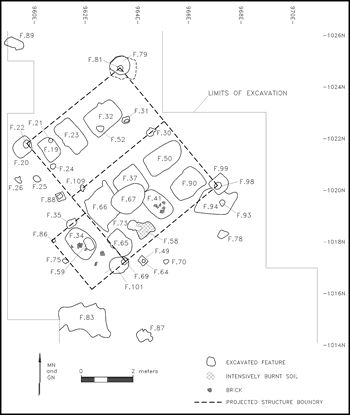Structure 2
 Structure 2 at Site 44JC969 is a rectangular building measuring approximately 15 x 20 feet. The building was constructed with earthfast posts (sunk into the ground) at each of its four corners and a chimney off-center on the southwest end of the structure. One subfloor pit was located outside the area defined by the corner support posts under a small shed-like addition, while eight additional subfloor pits were identified beneath the house. The post-style construction, the higher frequency of subfloor pits, and the overlapping of some of the subfloor pits in Structure 2 suggest that this cabin may have been built earlier and had a longer period of use than the other buildings.
Structure 2 at Site 44JC969 is a rectangular building measuring approximately 15 x 20 feet. The building was constructed with earthfast posts (sunk into the ground) at each of its four corners and a chimney off-center on the southwest end of the structure. One subfloor pit was located outside the area defined by the corner support posts under a small shed-like addition, while eight additional subfloor pits were identified beneath the house. The post-style construction, the higher frequency of subfloor pits, and the overlapping of some of the subfloor pits in Structure 2 suggest that this cabin may have been built earlier and had a longer period of use than the other buildings.
A large, shallow, subfloor depression, extending only a few inches into the subsoil, was identified beneath the southeast half of the house. Within this depression, fill from the destruction of the house covered the subfloor pits, hearth, and chimney construction/support features. The mixed oak species and maple identified in flotation samples from this large depression suggest the use of these woods in the construction of the building; the frequency of pine wood charcoal was far lower than elsewhere on the site.
 The chimney construction is uncertain, since nothing of the chimney was found in place. Rectangular, flat-bottomed, pit-like features located on either side of an area of charred/burned soil appear to be related to the construction and support of the chimney around the hearth, similar in some ways to a more substantial kitchen structure at nearby Kingsmill plantation. Though no intact brickwork was identified at Structure 2, some scattered brick fragments were found on either side of the likely hearth area, suggesting that a brick hearth and chimney were dismantled and scavenged from Structure 2, or perhaps a more impermanent hearth and chimney made of wattle and daub or other organic materials were present.
The chimney construction is uncertain, since nothing of the chimney was found in place. Rectangular, flat-bottomed, pit-like features located on either side of an area of charred/burned soil appear to be related to the construction and support of the chimney around the hearth, similar in some ways to a more substantial kitchen structure at nearby Kingsmill plantation. Though no intact brickwork was identified at Structure 2, some scattered brick fragments were found on either side of the likely hearth area, suggesting that a brick hearth and chimney were dismantled and scavenged from Structure 2, or perhaps a more impermanent hearth and chimney made of wattle and daub or other organic materials were present.
Subfloor pits were very common beneath Structure 2, with a total of nine identified. The three overlapping subfloor pits in front of the hearth are the largest and deepest. Originally, there were two side-by-side subfloor pits in front of the hearth that were basically square, with one of these exhibiting evidence of interior corner-bracing. After both of these earlier subfloor pits had been filled, an oval pit was excavated directly in front of the hearth, intruding into both of the earlier backfilled pits. These three hearthfront pits contained an assemblage of artifacts that is similar in many respects. All three pits contained wrought nails, various kinds of ceramic tableware, bottle glass, pipes, animal bone, iron objects, buttons, pharmaceutical vials, utensils, oyster shell, etc.  However, pewter objects, artifacts related to grooming, ointment pots and drug jars, door and window hardware, whetstones, and pieces of daub were recovered from what remained of both earlier, squarish pits, but not in the later oval pit.
However, pewter objects, artifacts related to grooming, ointment pots and drug jars, door and window hardware, whetstones, and pieces of daub were recovered from what remained of both earlier, squarish pits, but not in the later oval pit.
A minimum of 56 ceramic vessels were recovered from features associated with Structure 2. Creamware vessels include a cup/mug, plates, a bowl, teabowls, a platter, and an unidentified piece of hollowware. Coarse earthenware vessels include mugs, a bowl, dishes, pans, and a piece of unidentified hollowware. Chinese porcelain vessels include plates and saucers. Three Colonoware vessels were recovered, including two bowls and a piece of unidentified hollowware. White saltglaze stoneware vessels include two bowls and a plate, a teabowl, a saucer, and a chamberpot. Tin-enameled earthenware vessels include ointment pots, a drug jar, a basin, and two plates. Other vessels include a loving cup/footed bowl, two cups, a saucer, a pitcher, and several pieces of unidentified hollowware.
As with Structure 1, there was a very small amount of window glass recovered in association with Structure 2. Again, either the use of glass windows was very limited, or window glass was carefully salvaged when the structure was abandoned.














